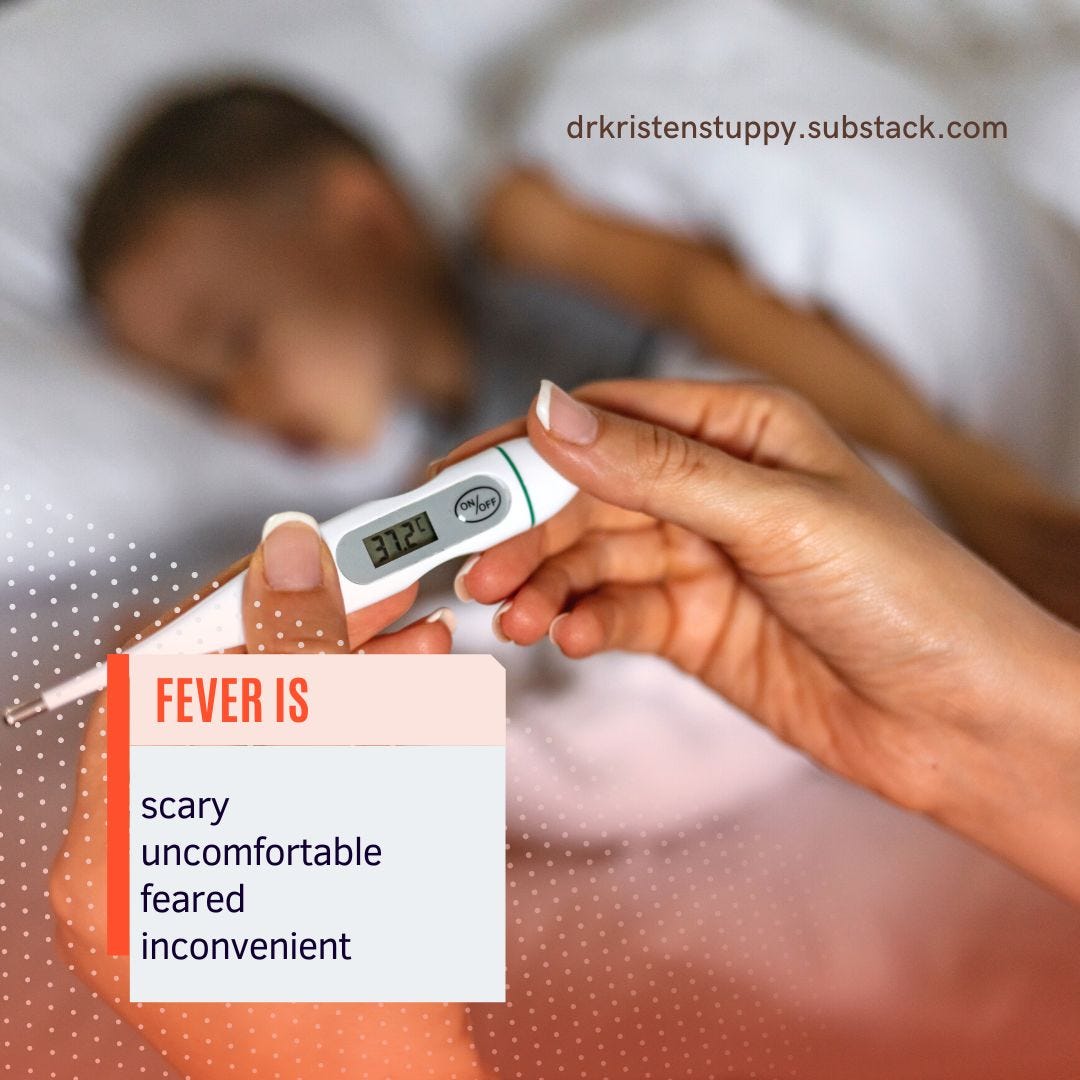Fever is...
Fever is scary to parents.
Parents hear about fever seizures and are afraid the temperature will get so high that it will cause permanent brain damage. In reality the way a child is acting is more important than the temperature. If they're dehydrated, having difficulty breathing, or are in extreme pain, you don't need a thermometer to know they're sick.
Fever is uncomfortable.
Fever can make the body ache. It's often associated with other pains, such as headache or muscle aches. Kids look miserable when they have a fever. They might appear more tired than normal. They breathe faster. Their heart pounds. They whine. Their face is flushed. They are sweaty. They might have chills, causing them to shake.
Fever is often feared as something bad.
Parents often fear the worst with a fever:
Is it pneumonia? Leukemia? Ear infection?
Fever is good in most cases.
In most instances, fever in children is good. It's a sign of a working immune system.
Fever is often associated with decreased appetite.
This decreased food intake worries parents, but if the child is drinking enough to stay hydrated, they can survive a few days without food. Kids typically increase their intake when feeling well again. Don't force them to eat when sick, but do encourage fluids to maintain hydration.
Fever is serious in infants under 3 months, immunocompromised people, and in under-immunized kids.
These kids do not have very effective immune systems and are more at risk from diseases their bodies can't fight.
Any abnormal temperature (both too high and too low) should be completely evaluated in these at risk children.
Fever is inconvenient.
I hate to say it, but for many parents it's just not convenient for their kids to be sick. A big meeting at work. A child's class party. A recital. A big game or tournament.
Whatever it is, our lives are busy and we don't want to stop for illness.
Unfortunately, there is no treatment for fever that makes it become non-infectious immediately, so it is best to stay home.
Don't expose others by giving your child ibuprofen and hoping the school nurse won't call.
Fever is a normal response to illness in most cases.
Most fevers in kids are due to viruses and run their course in 3-5 days.
Parents usually want to know what temperature is too high, but that number is really unknown (probably above 106F).
The height of a fever does not tell us how serious the infection is. The higher the temperature, the more miserable a person feels. That's why it's recommended to use a fever reducer after 102F.
The temperature doesn't need to come back to normal, it just needs to come down enough for comfort.
Fever is most common at night.
Unfortunately most illnesses are more severe at night.
This has to do with the complex system of hormones in our body. It means that kids who seem "okay" during the day have more discomfort over night.
This decreases everyone's sleep and is frustrating to parents, but is common.
Fever is a time that illnesses are considered most contagious.
During a fever viral shedding is highest. It's important to keep anyone with fever away from others as much as practical (in a home, confining kids to a bedroom can help).
Wash hands and surfaces that person touches often during any illness.
Wear quality masks (KN95, KF94) and ventilate and filtrate the air to prevent spread through the respiratory tract. (See tips below under “What you can do” for more details.)
Continue these precautions until the child is fever free for at least 24 hours without fever reducers. We know that people are still contagious after this, so continuing precautions longer is best. (Remember that temperatures fluctuate, so a few hours without fever doesn't prove that the infection is resolved.)
Fever is an elevation of normal temperature.
Normal temperature varies throughout the day and depends on the location the temperature was taken and the type of thermometer used. Digital thermometers have replaced glass mercury thermometers due to safety concerns with mercury. Ear thermometers are not accurate in young infants or those with wax in the ear canal. Plastic strip thermometers and pacifier thermometers give a general idea of a temperature, but are not accurate.
To identify a true fever, it's important to note the degree temperature as well as location taken. (A kiss on the forehead can let most parents know if the child is warm or hot, but doesn't identify a true fever and therefore the need to isolate to prevent spreading illness.) I never recommend adding or subtracting degrees to decide if it is a fever. You can look at a child to know if they're sick.
The degree of temperature helps guide if they can go to school or daycare, not how you should treat the child.
Fevers in children are generally defined as temperatures above 100.4 F (38 C) but some schools and daycares set temperatures at other levels.
Fever is rarely dangerous, though parents often fear the worst.
This is the time of year kids will be sick more than normal. Kids get sick more than adults. With each illness there can be fever (though not always).
Fever is not necessarily something that needs antibiotics.
It’s tempting to want to put a child on antibiotics when they look miserable with a fever, but if it’s a viral infection, the antibiotic does not help at all. It may even lead to more GI upset (diarrhea), bacterial resistance, or allergic reaction.
Only use antibiotics if there is concern for a bacterial infection.
What you can do:
Be prepared at home with a fever reducer and know your child's proper dosage for his or her weight.
Use fever reducers to make kids comfortable, not to bring the temperature to normal.
Push water and other fluids to help kids stay hydrated. They can eat foods if they feel up to it, but fluids are important!
Stay home when sick to keep from spreading germs. It's generally okay to return to work/school when fever - free 24 hours without the use of fever reducers unless you know you are still in the contagious window, such as the COVID rapid test is still positive.
Help kids rest when sick.
If the fever lasts more than 3-5 days, your child looks dehydrated, is having trouble breathing, is in extreme pain, or you are concerned, your child should be seen. A physical exam (and sometimes labs or x-ray) is needed to identify the source of illness in these cases. A phone call cannot diagnose a source of fever.
Any infant under 3 months or immunocompromised child should be seen to rule out serious disease if the temperature is more than 100.5.
For children over 3 months, there is NO MAGIC TEMPERATURE that we worry more about. Look at your child, not the thermometer.
Protect your family from spread of the infection within the home, regardless of what is causing it. No one likes to be sick and we have many ways to prevent spread, including
Encourage everyone able to wear a mask to wear a quality well fitted mask, such as a KN95 or KF94 (kid sizes available!). The person who is sick is the most effective mask wearer, but if your child is too young or uncomfortable to wear a mask, your mask can help protect you.
Filter the air.
You can make an effective but less expensive HEPA filter box fan with these DIY instructions.
Clean Air Stars has this helpful spreadsheet to help choose the right filter for your needs.
Run your heater or AC fan all the time by changing from “Auto” to “On” to help filter your air through the home’s HEPA filter.
Open windows to improve ventilation if weather permits.
Wash hands and surfaces frequently.
Isolate the sick family member as much as possible from others.
Stay up to date on all vaccines and boosters. This can help protect against serious illness.






